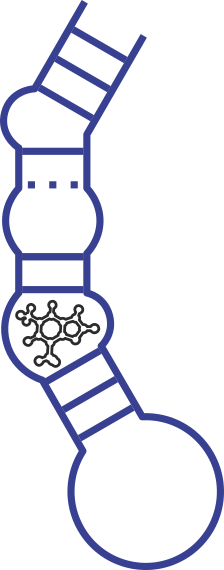Difference between revisions of "Template:Heidelberg/pages/overview/aptamers"
| Line 53: | Line 53: | ||
</div> | </div> | ||
</div> | </div> | ||
| − | + | <div class="col-lg-6"> | |
<p class="basictext"> | <p class="basictext"> | ||
It has been shown that selected aptamers can be used to make the catalytic activity dependent on the presence of a ligand.<x-ref>Soukup1999</x-ref> Fusions like that are called aptazymes. For this a catalytic domain has to interact via a communication module with an aptamer (Fig. 6). In presence of the ligand the aptamer undergoes conformational changes which results in an activation or inactivation of the catalytic activity. In our project we use different aptamers and combine them with catalytic nucleic acids to use them in various applications. In order to develop the necessary tools we need a fast and efficient way to generate new aptamers and aptazymes. To meet these needs we have developed two parts of software: One that generates aptamers from scratch (MAWS) and another one that joins them with an existing catalytic nucleic acid(JAWS) in an optimized way. This method not only is faster but also cheaper than existing methods. | It has been shown that selected aptamers can be used to make the catalytic activity dependent on the presence of a ligand.<x-ref>Soukup1999</x-ref> Fusions like that are called aptazymes. For this a catalytic domain has to interact via a communication module with an aptamer (Fig. 6). In presence of the ligand the aptamer undergoes conformational changes which results in an activation or inactivation of the catalytic activity. In our project we use different aptamers and combine them with catalytic nucleic acids to use them in various applications. In order to develop the necessary tools we need a fast and efficient way to generate new aptamers and aptazymes. To meet these needs we have developed two parts of software: One that generates aptamers from scratch (MAWS) and another one that joins them with an existing catalytic nucleic acid(JAWS) in an optimized way. This method not only is faster but also cheaper than existing methods. | ||
</p> | </p> | ||
| − | + | </div> | |
<div class="col-lg-6"> | <div class="col-lg-6"> | ||
<div class="imagewrapper"> | <div class="imagewrapper"> | ||
Revision as of 21:11, 18 September 2015
Aptamers

Aptamers are RNA or DNA sequences that can selectively bind to a ligand or target. Scientists have selected a variety of aptamers for small molecules ranging from theophylline (Fig. 4A) being one of the first described aptamers
Both catalytic nucleic acids and aptamers are as for today selected via systematic evolution of ligands by exponential enhancement

Systematic Evolution of Ligands by EXponential Enrichment, zu deutsch: Systematische Evolution von Liganden durch exponentielle Anreicherung (SELEX): Current method to select functional nucleic acids from a random library. Figure adapted from :Source
It has been shown that selected aptamers can be used to make the catalytic activity dependent on the presence of a ligand.
An aptamer connected via a communication module to an catalytic sequence; The communication module translates the interaction of the ligand with the aptamer to the catalytic part of the aptazyme.
Besides the above describes functional nucleic acids SELEX revealed aptamers which not only bind to a ligand but also are able to turn on fluorescence of different non-fluorescent dyes. An interesting example for an aptamer with such a special function is the Malachite Green Aptamer.

The Spinach Aptamer turns on fluorescence of its ligand upon bind it.
Though we so far mainly discussed functional RNA there are also both DNA aptamers and catalytic DNA which were selected using SELEX as well. As for today the concept of functional nucleic acids in nature has only been found for RNA. Nevertheless DNA aptamers and also catalytic DNA were selected in vitro.